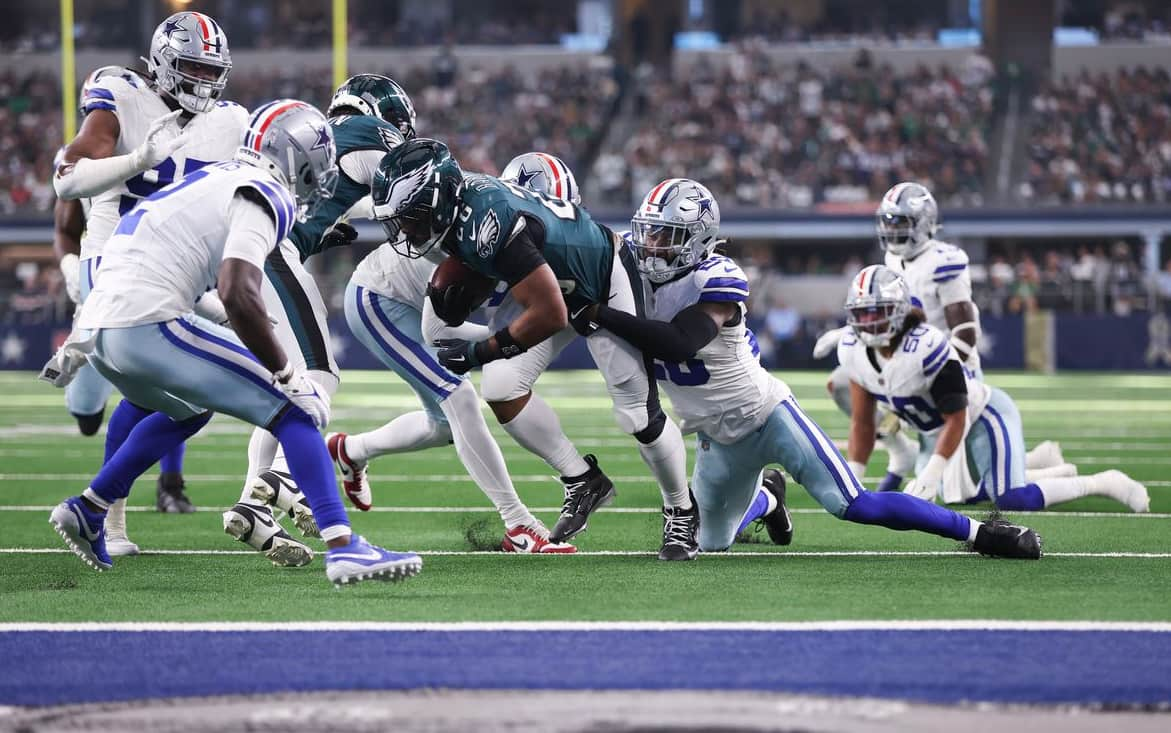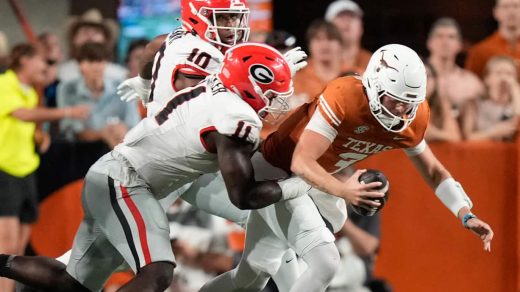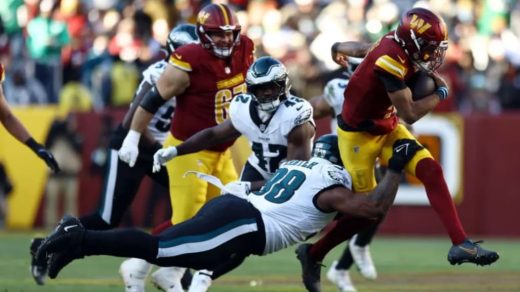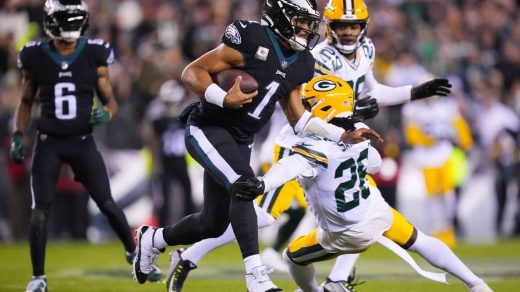In what began as a highly anticipated NFL matchup between two historic rivals, the Philadelphia Eagles delivered a masterclass performance, overwhelming the Dallas Cowboys with a decisive 41-7 victory.
This remarkable game, which took place at Lincoln Financial Field, showcased the Eagles’ exceptional execution in both offensive and defensive strategies while exposing several critical areas where the Cowboys need improvement.
The matchup drew significant attention not only for its divisional implications but also for the individual player performances that would ultimately shape the outcome of this crucial contest.
The eagles vs cowboys rivalry, one of the most storied in NFL history, added another memorable chapter with this game.
From the opening kickoff to the final whistle, viewers witnessed a display of tactical evolution, individual excellence, and team coordination that exemplified the highest level of professional football.
Dallas Cowboys Vs Philadelphia Eagles Match Player Stats

This comprehensive analysis will delve deep into the player statistics, strategic decisions, and key moments that defined this significant divisional clash.
Dallas Cowboys vs Philadelphia Eagles Match Score Box
| Quarter | Q1 | Q2 | Q3 | Q4 | Final |
|---|---|---|---|---|---|
| Dallas Cowboys | 7 | 0 | 0 | 0 | 7 |
| Philadelphia Eagles | 7 | 17 | 10 | 7 | 41 |
Dallas Cowboys Player Stats
Passing Performance Analysis
The Cowboys’ passing game showed significant struggles throughout the match, with detailed statistics revealing the following:
| Player | CP/ATT | YDS | TD | INT | FPTS | Completion % |
|---|---|---|---|---|---|---|
| C. Rush | 15/28 | 147 | 1 | 2 | 7 | 53.57% |
| T. Lance | 1/1 | 10 | 0 | 0 | 0 | 100% |
Key observations from the passing game:
- C. Rush’s Performance:
- Struggled with accuracy, completing only 53.57% of his passes
- Faced constant pressure from the Eagles’ defensive line
- Two critical interceptions severely impacted the offensive momentum
- Managed one touchdown pass despite defensive pressure
- T. Lance’s Limited Role:
- Perfect completion rate but minimal involvement
- Used primarily in specific package plays
- Showed potential in limited snaps
Rushing Performance Breakdown
The Cowboys’ ground game statistics revealed both promising moments and areas of concern:
| Player | ATT | YDS | TD | LG | FPTS | YPC |
|---|---|---|---|---|---|---|
| R. Dowdle | 23 | 104 | 0 | 17 | 9 | 4.52 |
| K. Turpin | 2 | 18 | 0 | 12 | 3 | 9.0 |
| E. Elliott | 3 | 20 | 5 | 0 | 0 | 6.67 |
| C. Rush | 1 | 20 | 2 | 7 | 0 | 20.0 |
| T. Lance | 1 | 10 | 1 | 0 | 0 | 10.0 |
Notable rushing game aspects:
- R. Dowdle’s Effective Running:
- Led the team with 104 yards on 23 carries
- Maintained a solid 4.52 yards per carry average
- Showed excellent vision in finding running lanes
- Demonstrated durability throughout the game
- Specialized Player Usage:
- K. Turpin’s explosive plays in limited touches
- Strategic usage of quarterbacks in running situations
- Varied personnel packages for different situations
Receiving Performance Analysis
The Cowboys’ receiving corps faced significant challenges but showed moments of promise:
| Player | TAR | REC | YDS | TD | LG | FPTS | Catch % |
|---|---|---|---|---|---|---|---|
| B. Cooks | 8 | 4 | 52 | 0 | 22 | 9 | 50% |
| J. Tolbert | 4 | 3 | 30 | 1 | 19 | 12 | 75% |
| J. Ferguson | 5 | 3 | 18 | 0 | 7 | 2 | 60% |
| K. Turpin | 4 | 1 | 16 | 0 | 16 | 3 | 25% |
Key receiving insights:
- Target Distribution:
- B. Cooks led with 8 targets but struggled with efficiency
- J. Tolbert showed promising efficiency with 75% catch rate
- Varied involvement of multiple receivers in the game plan
- Impact Plays:
- J. Tolbert’s touchdown provided a rare bright spot
- B. Cooks’ 22-yard reception was the longest of the game
- Limited yards after catch impacted overall effectiveness
Philadelphia Eagles Player Stats
Passing Performance Analysis
The Eagles’ quarterbacks demonstrated exceptional efficiency and decision-making:
| Player | CP/ATT | YDS | TD | INT | FPTS | Completion % |
|---|---|---|---|---|---|---|
| K. Pickett | 10/15 | 143 | 1 | 0 | 17 | 66.67% |
| T. McKee | 3/4 | 54 | 2 | 0 | 14 | 75% |
Notable passing game elements:
- K. Pickett’s Command:
- Maintained high efficiency with 66.67% completion rate
- Zero interceptions showed excellent decision-making
- Effective distribution to multiple receivers
- Strong performance under pressure situations
- T. McKee’s Impact:
- Impressive touchdown-to-attempt ratio
- Effective in red zone situations
- Showed excellent chemistry with receivers
Rushing Performance Analysis
The Eagles’ ground game proved to be a decisive factor in their victory:
| Player | ATT | YDS | TD | LG | FPTS | YPC |
|---|---|---|---|---|---|---|
| S. Barkley | 31 | 167 | 0 | 23 | 18 | 5.39 |
| T. Davis-Price | 3 | 70 | 5 | 0 | 0 | 23.33 |
| K. Gainwell | 3 | 40 | 4 | 1 | 0 | 13.33 |
Key rushing observations:
- S. Barkley’s Dominance:
- Outstanding 5.39 yards per carry average
- Consistent production throughout all quarters
- Excellent vision and decision-making in hole selection
- Effective in both power and speed situations
- Complementary Rushing Attack:
- T. Davis-Price’s explosive plays in limited attempts
- K. Gainwell’s efficient usage in specific situations
- Effective rotation keeps defense off-balance
Receiving Performance Breakdown
The Eagles’ receiving corps showcased depth and versatility:
| Player | TAR | REC | YDS | TD | LG | FPTS | Catch % |
|---|---|---|---|---|---|---|---|
| D. Smith | 7 | 6 | 120 | 2 | 49 | 30 | 85.71% |
| A. Brown | 5 | 3 | 36 | 1 | 20 | 12 | 60% |
| G. Calcaterra | 2 | 1 | 34 | 0 | 34 | 4 | 50% |
Key receiving insights:
- D. Smith’s Excellence:
- Outstanding catch rate of 85.71%
- Two crucial touchdown receptions
- Consistent threat in both short and deep routes
- Excellent yards after catch performance
- Balanced Distribution:
- Multiple receivers involved in the passing game
- Effective use of tight ends in passing schemes
- Strategic targeting based on defensive coverage
Dallas Cowboys vs Philadelphia Eagles Match Game Summary
The game unfolded as a masterclass in strategic execution by the Philadelphia Eagles, particularly after the first quarter.
Here’s a detailed breakdown of the game’s progression and key tactical elements:
First Quarter Development:
- Both teams traded early touchdowns, showing initial offensive capability
- Cowboys’ defense showed early promise but couldn’t maintain consistency
- Eagles began establishing their running game foundation
Second Quarter Dominance:
- Eagles’ offensive line began controlling the line of scrimmage
- Multiple defensive adjustments disrupted Cowboys’ rhythm
- Seventeen unanswered points shifted momentum decisively
Third Quarter Execution:
- Eagles continued building lead with balanced attack
- Cowboys struggled to establish offensive consistency
- Defensive pressure led to crucial turnovers
Fourth Quarter Closure:
- Eagles maintained control through clock management
- Cowboys unable to mount significant comeback attempt
- Effective game management secured decisive victory
Key Highlights
Offensive Excellence:
- DeVonta Smith’s 120-yard, 2-touchdown performance
- Saquon Barkley’s dominant 167-yard rushing display
- Eagles’ balanced attack with 197 passing yards and 277 rushing yards
Defensive Dominance:
- Two critical interceptions against C. Rush
- Consistent pressure on Cowboys’ quarterbacks
- Effective run defense in crucial situations
Strategic Superiority:
- Eagles’ effective use of personnel rotation
- Successful adaptation to Cowboys’ defensive schemes
- Excellent clock management throughout the game
Individual Achievements:
- D. Smith’s career-high performance
- S. Barkley’s impressive yards per carry average
- Multiple players contributing to scoring drives
More American Football Posts:
Conclusion:
This comprehensive analysis of the Dallas Cowboys vs Philadelphia Eagles matchup reveals several crucial insights about both teams.
The Eagles’ dominant 41-7 victory showcased their superior execution in all phases of the game, from offensive efficiency to defensive excellence.
Their ability to maintain consistent pressure while adapting their strategy throughout the game proved decisive.
The performance highlighted the Eagles’ depth and versatility, with multiple players making significant contributions across different aspects of the game.
Their balanced attack, featuring both an effective passing game and a dominant rushing attack, provides a template for successful NFL game planning and execution.
For the Cowboys, this game exposed several areas requiring attention, particularly in pass protection, defensive coordination, and offensive consistency.
However, the experience gained from this matchup provides valuable insights for future strategic adjustments and player development.
The implications of this game extend beyond the final score, potentially influencing both teams’ approaches to future matchups and their overall season strategies.
The Eagles have established themselves as a formidable force in the division, while the Cowboys have clear objectives for improvement as they move forward in the season.
This matchup serves as a testament to the importance of comprehensive game planning, effective execution, and the ability to adapt strategies as circumstances change during a game.
The lessons learned from this contest will undoubtedly influence both teams’ approaches to future competitions and their ongoing development throughout the season.


